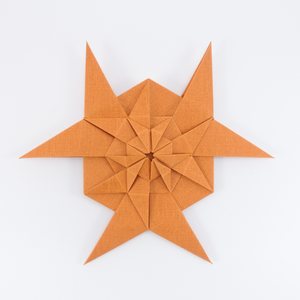Scissors Fractal

This is a recursive version of Shuzo Fujimoto’s Scissors (CFW 87). I wanted to call it Biohazard Fractal since it resembles the biohazard symbol, but later decided to stay with the name Fujimoto used for his base model.
I am not sure whether Fujimoto was aware of the possibility of extending his original CFW 87 design into a fractal. I discovered that a number of his molecules can be fractalized this way (pictures coming up) but the only example of him using such a procedure is the Lucky Star Fractal which is derived from CFW 88 (Hemp Leaf) in a similar manner. Since I was aware of Lucky Star Fractal and it still took me quite a while to realize that the process could be generalized to other molecules, unless I find firm evidence to the contrary, I will assume Fujimoto did not know of the other fractal designs.
While Lucky Star Fractal has six-fold symmetry, Scissors has only tri-fold symmetry. This means that each consecutive level of the fractal can be rotated relative to the previous one in two ways rather than one. The model presented here uses consistent rotation on all levels. Another highly symmetric possibility is alternating the direction every other level. I also took a picture comparing both variants side by side. However, the direction for each level is independent, so completely random assignment is possible as well.
Since the outermost level of the fractal resembles the base molecule from which it is derived, it shares its properties in that it can be tessellated. Due to the way layers of paper lock together, this molecule is harder to fold than Lucky Star Fractal, especially at deeper levels. Since accessing those deep layers requires opening up the molecule significantly, tessellating it will probably also be quite challenging in practice. The shrink factor is √3 (same as for Lucky Star Fractal and other fractals in this family) which means consecutive levels become smaller quite fast. This work has just 3 levels, but I had to use 35 cm paper to get there. I could add one or two more, but they would not end up neat (more due to the difficulty accessing deep layers than to shrinking).
Comments